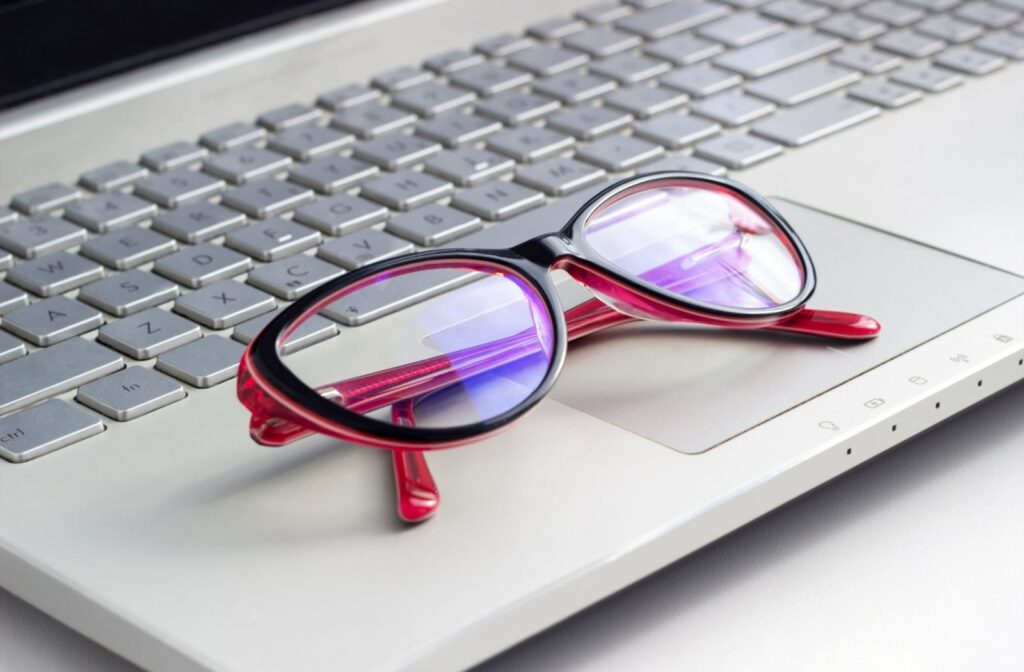In today’s digital age, many of us spend countless hours in front of screens, whether it’s for work, entertainment, or communication.
With this increased screen time comes exposure to blue light, which has raised concerns about its potential effects on eye health. As a result, blue light protection for glasses has become a popular topic. Blue light protection for glasses refers to the use of special lenses designed to filter out or block blue light from reaching the eyes.
Total Focus Optometry offers a wide range of frames and lenses, all of which can have a special blue light protection coating applied–even our sunglasses!
Our eye care specialists are happy to help you pick out the perfect pair of glasses for your needs, and if you have any concerns about your eyes or your prescription, we can get you in for an eye exam to take a look.
What Is Blue Light?
Our surroundings are brimming with electromagnetic energy, which exists all around us and even passes through us as waves. These electromagnetic waves vary in size, with the longer ones encompassing:
- Radio waves
- Microwaves
- Infrared waves
- Ultraviolet (UV) waves
The electromagnetic spectrum also contains much shorter waves, such as X-rays and Gamma rays.
The majority of these waves are beyond human perception. However, there’s a slim section of this spectrum, known as visible light, that we can see. The spectrum of visible light stretches from wavelengths of 380 nanometers (reflecting violet light) to 700 nanometers (indicating red light).
Blue Light Wavelength
The rule of thumb is that shorter wavelengths convey more energy. Blue light stands out due to its short, high-energy wavelengths, positioning it just above UV waves on the spectrum. While UV rays are invisible to the naked eye and have been highlighted by health specialists for their potential to damage both our skin and eyes, blue light possesses nearly equivalent intensity.
Blue light wavelengths are marginally longer and slightly less intense than those of UV rays, placing them near each other in terms of energy level.
What Creates Blue Light?
Blue light is emitted by various sources, both natural and artificial. The primary natural source is the sun, which covers the earth in blue light as part of the visible light spectrum. However, artificial sources are just as abundant, particularly through the adoption of LED technology.
Devices such as computer monitors, laptops, smartphones, tablets, and flat-screen TVs all incorporate LED technology, which emits significant levels of blue light. Fluorescent and incandescent bulbs are also notable contributors to the blue light we encounter daily. We are exposed to an unprecedented amount of blue light in our modern world as a result.
Understanding the Concerns
One of the main concerns about blue light is its potential to disrupt our circadian rhythm. Exposure to blue light in the evening can interfere with the production of melatonin, the hormone responsible for regulating sleep. This disruption can lead to difficulty falling asleep and poor sleep quality, which can have a range of negative impacts on overall health and well-being.
Some studies suggest that prolonged exposure to blue light may contribute to digital eye strain, also known as computer vision syndrome. Symptoms of digital eye strain include eye discomfort, dryness, blurred vision, headaches, and neck and shoulder pain.
While more research is needed to fully understand the long-term effects of blue light exposure, taking steps to minimize exposure is prudent, especially given the prevalence of digital devices in our daily lives.
Blue Light Protection for Glasses
Blue light protection for glasses involves the incorporation of special lens coatings or materials designed to filter out or block a portion of the blue light emitted by screens. These lenses can potentially mitigate the disruption of sleep patterns caused by excessive blue light exposure.
There are different types of blue light-blocking lenses available, ranging from those that filter out only a small percentage of blue light to those that provide more comprehensive protection. Some lenses have a slight yellow or amber tint, while others are virtually clear. The type of lenses you receive ultimately depends on individual preferences and needs.
Benefits of Blue Light Protection Glasses
Investing in blue light protection glasses can offer several benefits:
- Reduced Eye Strain: By filtering out blue light, these glasses can help alleviate symptoms of digital eye strain, making it more comfortable to spend extended periods in front of screens.
- Improved Sleep Quality: Wearing blue light protection glasses in the evening may help minimize the disruption of melatonin production, leading to better sleep quality and overall well-being.
- Preservation of Eye Health: While more research is needed, protecting your eyes from excessive blue light exposure may help maintain long-term eye health and reduce the risk of potential damage associated with prolonged screen time.
Prioritizing Eye Health in the Digital Age
Blue light protection for glasses offers a proactive approach to mitigating the potential negative effects of excessive screen time on eye health and sleep quality.
By investing in glasses with blue light-blocking lenses, individuals can enjoy greater comfort, improved sleep, and potentially reduced long-term risks associated with digital eye strain.
While further research is warranted, incorporating blue light protection into your eyewear regimen may be a wise decision in today’s technology-driven world.
Total Focus Optometry provides an extensive selection of frames and lenses, each with a special coating for blue light protection. Stop by our office today and meet our dedicated eye care team—we are eager to help you find your ideal blue light-blocking glasses!



